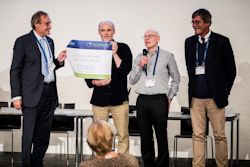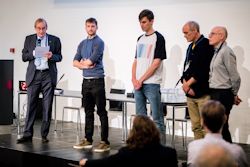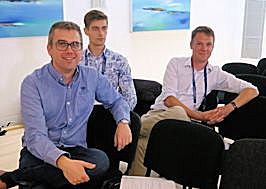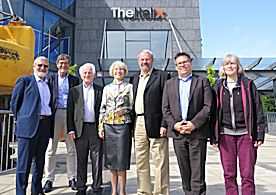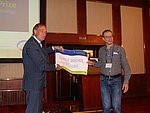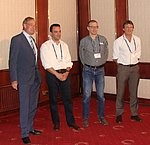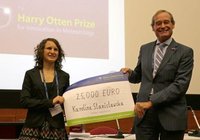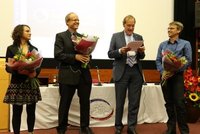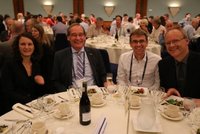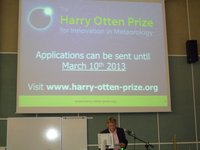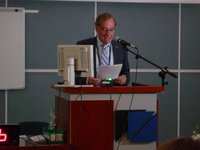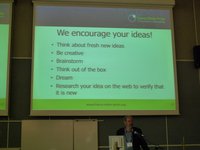2023 Prize
The Harry Otten Prize for Innovation in Meteorology has been awarded for the sixth time. During the Annual Meeting of the European Meteorological Society in Bratislava, the jury announced that Hamish Pritchard from the British Antarctic Survey (U.K.) has won the first prize of 25,000 Euro. His idea, Lakes as snowfall sensors: Solving the precipitation problem in the mountain cryosphere, entails that lakes can be used as pressure-sensing surfaces to yield accurate observations of the water content of snowfall simply, cheaply, autonomously, and over large areas. With standard water-pressure sensors submerged on a lakebed, the mass of winter snow precipitation as it reaches the lake surface can be recorded, while avoiding biases that appear with other instruments that interact with snow as it falls or accumulates.
The winner of the prize was selected from three finalists. The other two finalists received 2,500 Euros for their ideas.
Philipp Gasch from the Karlsruhe Institute for Technology and his co-workers James Kasic and Zhien Wang (both at University of Colorado) presented their idea called “A novel airborne Doppler lidar system design for high-resolution wind measurements”. They propose a new airborne Doppler lidar onboard research aircraft, aiming to provide higher measurement accuracy and spatial resolution, in combination with a simplified and more robust system design. Its high resolution and accuracy allows for the retrieval of turbulence properties, such as vertical wind variance and turbulent kinetic energy.
A team composed of Irene Schicker, scientist at GeoSphere and Marianne Bugelmayer-Blaschek and Jasmin Lampert (both at the Austrian Institute of Technology) proposed to refine seasonal forecasts in their idea Weather impacts on renewables & agriculture: explainable AI for hyperresolution downscaling for S2S. While extended range and seasonal forecasts are rapidly developing, they lack the spatial resolution necessary for applications operating at a smaller scale. Since dynamic downscaling is computationally expensive, they aim to develop a novel, computationally inexpensive, transferable, and physics-aware post-processing methodology and establish trustworthiness within the scientific community and the public, and assess transferability to untrained regions.
2021 Prize
The Harry Otten Prize for Innovation in Meteorology has been awarded for the fifth time. During the Annual Meeting of the European Meteorological Society currently taking place virtually, the jury announced that Kirien Whan, from the Royal Netherlands Meteorological Institute (KNMI) and Kate Saunders from the Queensland University of Technology (QUT) have won the first prize of 25,000 Euro. Their idea, Second Wind: Extending the official wind gust record with citizen science observations, is to use citizen observations of wind gusts, apply new methods of quality control to them and integrate the data into observations taken from standard measurement networks. Wind gusts are causing severe damages. Every seven out of eight weather warnings issued by KNMI in 2018 involved extreme wind gusts. Often, high wind gusts occur very locally, in between the traditional measurement network. A more detailed picture of the wind gusts can help to alert the public further in advance and more accurately.
The winners of the prize were selected from three finalists. The other two finalists received 2,500 Euros for their ideas.
Moritz Mauz from the University of Tübingen in Germany presented his innovative idea called A high-frequency chilled-mirror hygrometer for turbulent stationary and airborne dew-point measurements. He proposed a small, lightweight, accurate and fast instrument that can measure turbulent moisture fluxes. The instrument can be operated on the ground or even mounted on an unmanned aircraft. This can help to better understand moisture fluxes in the boundary layer and eventually improve weather forecasts.
Joshua Soderholm from the Australian Bureau of Meteorology called his idea Observing the Impossible – in situ observations of hail trajectories using the HailSonde. His goal is to release probes into thunderstorms to better understand the path hail stones take within the cloud until they hit the ground. The benefits would be more accurate predictions of hail events reducing false alarms. Retrospectively, more precise hail swaths can help insurances to better deal with hail events, also in urban areas.
2019 Prize
The Harry Otten Prize for Innovation in Meteorology has been awarded for the fourth time on 10 September, 2019 during the Annual Meeting of the European Meteorological Society in Copenhagen, Denmark. Harry Otten announced the winners, Malcolm Kitchen from the UK Met Office and Chris Brunt from the University of Exeter, UK, for their idea A New Method of Measuring Atmospheric Refractivity. The idea is to obtain information of the refractivity of the atmosphere by measuring the angle of arrival of radio signals routinely broadcast by commercial aircraft. The angle of arrival would be measured at hill-top sites using a simple two-element interferometer. Knowledge of the aircraft location and the angle of arrival will enable the bending angle of the signals to be calculated. A measurable angle will only occur at grazing incidence, sources of signals either very close to the horizon, or at a similar height to the interferometer are essential. The routine navigational data broadcasts from civil aircraft represent the ideal source. The method generates important information on the humidity between the airplane and the measuring instrument. Knowing the moisture distribution in the atmosphere is very important for computer calculations of the weather. Shower prediction, for instance, could be improved with their method. They demonstrated the viability of the idea using a preliminary setup in southwest England.
The winners of the prize were selected by the Board of the Harry Otten Foundation out of three finalists. The other two finalists received 2’500 Euros for their ideas:
Yann Dufournet, Igor Stepanov, and Geanny Amos dos Santos from SkyEcho in The Netherlands presented their innovative idea called enLIGHT – A new way to communicate high definition weather data about the incoming weather hazards to citizens. They propose to use high resolution weather radar and nowcasting to warn urban residents about hazardous weather on very short timescales. They demonstrated their idea for the city of Rotterdam.
Paul Petersik from Germany discussed his idea called VineForecast – A tool to generate individual predictions of vine diseases and phenology. The goal is to predict the risk of outbreaks of mildew in vineyards using high resolution model output, local observations, and machine learning algorithms. This would provide vineyard owners with timely warnings of possible disease outbreaks thus preventing overuse of fungicides.
2017 Prize
The Harry Otten Prize for Innovation in Meteorology was awarded for the third time on 5 September, 2017 during the Annual Meeting of the European Meteorological Society in Dublin, Ireland. Harry Otten announced the winner, Lee Chapman, Professor at the School of Geography, Earth and Environmental Sciences, University of Birmingham, UK, for his idea High-Resolution Monitoring of Weather Impacts on Infrastructure Networks. Chapman’s idea is to use the “internet of things” and low-cost sensors to monitor the weather on a very dense network to improve short-range forecasting. Chapman illustrated his idea with three examples: WinterSense, AutumnSense, and SummerSense.
WinterSense is an idea to reduce the amount of salt and other corrosive materials put on roads during icy conditions by using high-resolution forecasts that pinpoint where ice is actually occurring or likely to occur. By improving monitoring and forecasting of road icing conditions, Chapman hopes to save £100m per year in the U.K. as well as reduce the amount of corrosive chemicals put on highways by avoiding dispersing these chemicals unnecessarily.
AutumnSense is an idea to use leaf wetness sensors on railway tracks to monitor the occurrence of slippery wet leaves on the tracks. Wet leaves on the track accompanied by a small amount of moisture compact and create a Teflon-type coating on the top of the track, which can degrade braking performance, which in turn can cause delays due to platform over-runs and worse still, signals passed at dangerous locations.
SummerSense is an idea to better monitor extreme heat conditions on railway tracks, which can cause buckling of the tracks and failure of lineside equipment through overheating. In the U.K. Network Rail already has a range of weather monitoring equipment and temperature solutions on the railway network, however, this network is too coarse for the application outlined and there is a need to fill gaps with cheaper alternatives.
Chapman’s idea is to use the internet of things (IoT), with “things” being small, low-cost sensors, to monitor and report in real time over the internet hazardous conditions such as those described above. The IoT approach can significantly reduce the costs by providing low-cost, low-power sensors embedded in an existing communications mesh.
The winner of the prize was selected by the Board of the Harry Otten Foundation out of three finalists. The other two participants in the final round received 2500 Euro for the following ideas:
Tom de Ruijter, a computer scientist at Big Data Republic in the Netherlands, for his innovative idea:Making use of errors in consumer weather data to derive advanced weather parameters. De Ruijter proposed to use errors in ground surface measurements to derive information about meteorological conditions such as nighttime cloud cover and snow vs. rain conditions.
Gert-Jan Steeneveld and Sytse Koopmans, Wageningen University in the Netherlands for their idea CrowDat@ssimilation: Assimilation of crowdsourced meteorological data in NWP models to improve small-scale weather forecasts. The basis of this idea is to use crowdsourced data in high-resolution numerical weather forecast models to improve short-range forecasts.
2015 Prize
The Harry Otten Prize for Innovation in Meteorology was awarded for the second time on 8 September, 2015 during the Annual Meeting of the European Meteorological Society in Sofia, Bulgaria. Harry Otten announced that the Board of the Harry Otten Foundation had selected Olivier Boucher as the winner of the 2015 prize of 25 thousand Euro for his idea “Probing the Upper Atmosphere by watching aircraft.”
Boucher’s winning idea is to use a simple all-sky camera to observe condensation trails from aircraft, those long clouds that sometimes form behind flying planes. This detection can be greatly facilitated if you know where to look for them, using an aircraft message receiver that gives the location of all aircraft flying above the receiver.
The camera measures the width and length of the contrails and their changes over time. These images provide valuable information about humidity and wind that can be used to improve numerical weather model forecasts. Such information, which will be taken mostly in clear air, will complement information from satellite observations of clouds and their motion.
This proposal was evaluated as scientifically sound, technically feasible and highly innovative. Its potential to improve the quality of global weather forecasts would benefit all users of weather forecasts.
Olivier is a research director of the French Centre Nationale de la Recherche Scientifique since 2011, after spending 6 years with the Met Office Hadley Centre in the United Kingdom.
The winner of the prize has been selected out of three finalists. The other two participants in the final round received 2500 Euro for the following ideas:
Rogiros Tapakis and Alexandros Charalambides (Cyprus University of Technology) for their idea to use a solar measurements from a dense network of photovoltaic cells to help electrical power generation companies manage the balance of sources of power.
Tim Hewson and Florian Pappenberger (Eureopean Centre for Medium Range Weather Forecasting) for their idea to predict small scale flash floods using forecast from much larger scale global weather prediction models.
Overall the jury received 13 applications for the prize from different European countries, Israel, and Cuba. The Harry Otten Prize is awarded every two years. More information is available at the website at www.harry-otten-prize.org.
Richard Anthes, Chairman of the Board of the Harry Otten Foundation, said “the finalists for this round of the Harry Otten Prize contributed outstanding examples of innovative ideas that have the potential for applications to benefit society.”
Harry Otten, founder of the Harry Otten Foundation, added “I am delighted that the prize has been awarded for such an innovative proposal. Using photographs from the condensation trails from aircraft can bring in new and valuable information to improve global weather forecasts, which will benefit all societies in the world.”
2013 Prize
The Harry Otten Prize for Innovation in Meteorology was awarded for the first time during the Annual Meeting of the European Meteorological Society in Reading (UK) on September 11, 2013. Harry Otten announced that the jury has decided that Karolina Stanisławska with her idea “Social media for meteorological prediction and information” won the prize, which is endowed with 25,000 Euro.
The idea “Social media for meteorological prediction and information” proposed by Karolina Stanisławska is about constructing a meteorological system based on the information extracted exclusively from social media content. The system would be a service providing crowdsourced information about actual weather conditions, identification of hazardous weather events and reaction of people to weather information.
Karolina was born in Poland and graduated in computer science at the Poznań University of Technology in 2011. She currently works as a researcher in climate modelling and greenhouse gases topics for the Finnish Meteorological Institute in Helsinki.
The winner of the prize was selected from three finalists. The other two finalists received 2,500 Euro for the following ideas:
The “Global Weather Alliance – the WeatherShare service – wxshare.org” by Karl H. Eggestad is a free and open video and audio clip and image material service specifically targeted for the worldwide weather broadcasting community.
“Forecasting and Mapping Ice Thickness for Ice Skating on Natural Lakes and Canals” by Gert-Jan Steeneveld, Bert Heusinkveld and Kevin Damman aims at improving the quantitative forecasting of ice growth and communicating this in a fast way to the general public.
Overall the jury received 19 applications for the prize mainly from different European countries and the USA. The Harry Otten Prize is awarded every two years.
Hans Reiff, Chairman of the jury: “Karolina’s idea is highly innovative with significant potential benefits to society. These benefits include both use of people to provide weather data and information to meteorologists through the social media as well as information on how society reacts to weather information and forecasts from meteorologists.“
Harry Otten, Founder of the Harry Otten Foundation: “I am delighted that the Prize has been awarded to such an innovative proposal. I hope that the Prize helps to put her idea into practice.”
2012 Prize Round
Even though it was the first round of the prize, a total of 12 applications was received. However, in the opinion of the jury, no application fulfilled all the criteria to win the prize.
The jury decided to issue honorable mention awards to two applications though, and granted 500 Euro to each of the authors:
Felicity Ahafianyo: Bringing Weather Information to the Door Steps of Ghanaians
Ms. Ahafianyo is working for the Ghanian Meteorological Agency. She noticed that weather and climate information is not always fully recognized in Ghana, especially by farmers who would need them most. She therefore proposed to educate through television and by publishing a weather calendar which explains the climate of each month in the different regions of Ghana. Additionally lessons in schools are part of the program she brought forward.
Martijn Koomen: Weather, Feathers and Frost
Mr. Koomen is a graduate from the Design Academy Eindhoven (NL). He proposed to built a piece of art to visualize wind by feathers being kept between two glasses.
